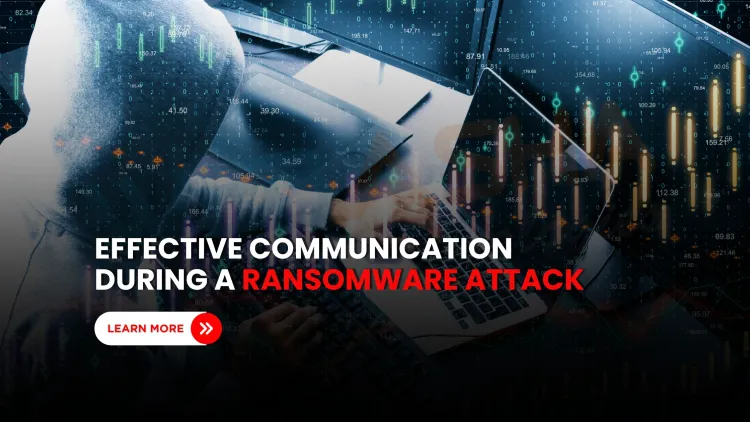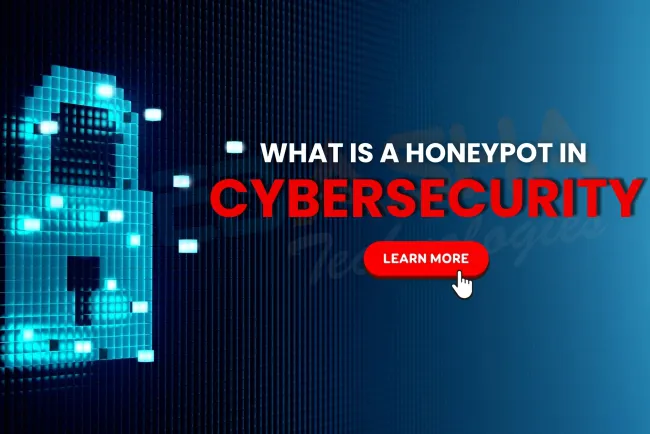How should companies communicate during a ransomware attack to reduce damage and panic?
Effective communication during a ransomware attack is as vital as technical response. When systems are compromised, timely and coordinated communication helps maintain trust, prevent misinformation, and meet legal obligations. This blog explores how organizations can prepare communication strategies in advance, activate them during an incident, and manage post-incident messaging to stakeholders, regulators, and the public. Real-time examples and tools are shared to help security architects and leaders build strong incident response communication protocols.

Table of Contents
- What Is the Importance of Communication During a Ransomware Attack?
- What Happens During a Ransomware Attack?
- Why Communication Is as Important as Containment
- Key Stakeholders in Ransomware Incident Communication
- Real-Time Communication Best Practices During an Attack
- Real-Time Example: Communication Gone Right
- Post-Incident Communication Strategy
- Regularly Test Communication Plans
- Tools to Support Cyber Incident Communication
- Key Takeaways for Security Leaders
- Conclusion
- Frequently Asked Questions (FAQs)
What Is the Importance of Communication During a Ransomware Attack?
When a ransomware attack hits, every second counts. While many organizations focus on the technical aspects—restoring backups, isolating systems, and involving cybersecurity experts—one of the most critical (and often overlooked) elements is effective communication.
A poorly managed communication strategy can lead to confusion, misinformation, and reputational damage. On the other hand, a proactive communication plan helps ensure coordinated internal response, accurate public messaging, and regulatory compliance.
What Happens During a Ransomware Attack?
A ransomware attack typically begins when malicious software encrypts the victim’s files or systems. The attacker then demands payment (usually in cryptocurrency) in exchange for the decryption key. During this time, internal operations, customer services, and external partnerships can all come to a standstill.
Common Impacts:
-
Data inaccessibility
-
Customer service outages
-
Legal and financial repercussions
-
Damage to brand trust
Why Communication Is as Important as Containment
While IT teams work to stop the spread and recover data, executives, HR, legal teams, and PR must manage the human and business side of the crisis.
Without a well-structured communication strategy:
-
Stakeholders may panic or make wrong decisions
-
Misinformation can damage public trust
-
Employees may fall for follow-up phishing campaigns
-
Regulators may penalize late or misleading notifications
Key Stakeholders in Ransomware Incident Communication
During a cyber incident, multiple stakeholders must be informed—but each with the right message:
| Stakeholder | What They Need to Know | Who Should Communicate |
|---|---|---|
| Employees | What systems are affected, what actions to take | IT + HR |
| Customers | Service disruptions, data impact (if any) | Customer Support + PR |
| Legal/Compliance | Breach reporting timelines, liabilities, regulations | CISO + Legal Counsel |
| Media/Public | High-level facts and next steps | PR/Corporate Communications |
| Executives/Board | Business impact, strategy, recovery progress | CISO + CEO |
| Regulators | Compliance with data breach laws and reporting rules | Legal + Compliance Officer |
Real-Time Communication Best Practices During an Attack
1. Activate Your Cyber Incident Response Plan
Before the panic spreads, activate your predefined communication plan. Make sure each team member understands their role and messaging responsibilities.
2. Designate a Single Source of Truth
Avoid conflicting messages. Assign a communications lead or team who owns all public and internal messages.
3. Draft Clear Internal Memos
Your employees are your frontline. Alert them quickly with a summary:
-
What’s happening?
-
What’s being done?
-
What should they do or avoid?
4. Use Out-of-Band Channels If Email Is Compromised
If your email or messaging systems are impacted, switch to alternative channels like SMS, phone trees, or secure messaging platforms (e.g., Signal).
5. Prepare Media Holding Statements
Even if full details aren’t available, have pre-approved holding statements ready like:
“We are currently investigating a security incident. Our teams are working to resolve it as quickly and securely as possible.”
Real-Time Example: Communication Gone Right
Case Study: Colonial Pipeline (2021)
Despite being heavily criticized for paying the ransom, Colonial Pipeline’s executive team communicated transparently. They informed federal agencies, issued public updates, and worked with cybersecurity experts—all while keeping their stakeholders informed.
The result? Fast operational recovery and reduced long-term reputation damage.
Post-Incident Communication Strategy
Once systems are restored and the threat is neutralized:
-
Send detailed updates to stakeholders on what happened and how it was handled.
-
Notify affected individuals (if PII or financial data was exposed).
-
Share lessons learned and improvements made to prevent recurrence.
-
Engage with regulators if mandated (e.g., GDPR, HIPAA, RBI, etc.).
Regularly Test Communication Plans
Cyber incidents are chaotic. Test your communication protocols during cyber incident response drills at least quarterly. Make sure:
-
All contact numbers and emergency access methods work
-
Everyone knows their role in communication
-
Backup communication channels are tested
Tools to Support Cyber Incident Communication
-
Slack or MS Teams (for internal updates)
-
Everbridge (crisis notification system)
-
Signal / ProtonMail (secure communication when systems are compromised)
-
PR agency on retainer (for high-profile breaches)
Key Takeaways for Security Leaders
-
Communication is not a luxury—it’s a mission-critical pillar of incident response.
-
Develop and test an actionable communication plan before an attack occurs.
-
Ensure transparency, but avoid speculation in public messages.
-
Use secure, reliable channels and designate clear roles for messaging.
-
Communication, when done right, protects your brand, your customers, and your business.
Conclusion
Ransomware attacks are no longer a question of "if" but "when." While having the best firewalls and antivirus is essential, having a clear, practiced, and effective communication strategy is just as critical to surviving a ransomware event with minimal fallout.
FAQs
What is ransomware?
Ransomware is a type of malicious software that encrypts data and demands payment for its release.
Why is communication important during a ransomware attack?
It ensures stakeholders are informed, panic is minimized, and regulatory obligations are met.
Who should be informed first during a ransomware incident?
Internal teams like IT, HR, and executives should be informed immediately, followed by legal, PR, and affected users.
What should employees be told during an attack?
They should receive clear, factual updates on what to avoid (e.g., opening suspicious emails) and how to stay secure.
What’s the role of the legal team in ransomware communication?
They ensure that communication aligns with data privacy laws and mandatory reporting regulations.
How can companies avoid spreading misinformation during an attack?
By assigning a central communications team or spokesperson to manage all messaging.
What communication channels are best if email is compromised?
Secure alternatives like Signal, SMS, or encrypted platforms like ProtonMail.
What are holding statements in cyber incident communication?
Pre-approved public statements that acknowledge the issue while investigations are ongoing.
How should customers be notified about a ransomware breach?
Through direct email, official website updates, and press releases when necessary.
What role does PR play in cyber incident management?
PR manages public perception and coordinates external communication with clarity and control.
How quickly should regulators be informed after a ransomware attack?
Depending on the jurisdiction, within 24 to 72 hours of confirming a data breach.
Can communication during an attack reduce legal liability?
Yes, transparent and timely disclosure helps meet regulatory requirements and builds trust.
How do you test your ransomware communication strategy?
Through regular cyber incident response drills that simulate communication under pressure.
What is an out-of-band communication channel?
A separate system (like phone or secure messaging) used when main networks are down or compromised.
Should communication be transparent even if all facts are not yet known?
Yes, but avoid speculation. Stick to verified information and commit to updates.
What are common communication mistakes during ransomware events?
Delays, conflicting messages, lack of updates, and ignoring internal staff communications.
How do communication plans fit into incident response planning?
They’re a core part of it, ensuring the human and business side of the crisis is managed.
What’s the impact of poor communication during a ransomware breach?
Confusion, misinformation, damaged brand trust, and potential fines from regulators.
How can security architects prepare communication frameworks?
By creating messaging templates, identifying stakeholders, and training teams beforehand.
Is it okay to admit to paying the ransom?
It depends. If disclosed, the organization should explain the decision and security improvements post-payment.
Can communication stop follow-up phishing attacks?
Yes, by warning users about likely social engineering attempts and how to report them.
How can executives be trained for communication during a ransomware event?
Through tabletop exercises and media training sessions led by crisis communication experts.
What are the legal risks of not disclosing a ransomware breach?
Non-compliance penalties, lawsuits, and reputation damage due to lack of transparency.
Should companies hire a PR firm for cyber incidents?
Yes, having one on retainer ensures faster, professional handling of public messaging.
What should be in a post-incident communication?
A summary of what happened, what was done to resolve it, what data was impacted, and next steps.
How do companies inform international stakeholders in a ransomware attack?
With translated, jurisdiction-specific communication and alignment with global data laws.
How often should the communication plan be updated?
At least once a year or after major organizational or regulatory changes.
What communication templates should companies have ready?
Internal alerts, customer FAQs, press releases, regulator reports, and employee notices.
How does communication differ for internal vs. external audiences?
Internal focuses on roles and instructions; external focuses on updates, reassurance, and legal language.
Should cyber insurance cover communication costs?
Yes, many cyber insurance policies include PR and legal communication assistance.











![Top 10 Ethical Hackers in the World [2025]](https://www.webasha.com/blog/uploads/images/202408/image_100x75_66c2f983c207b.webp)



![[2025] Top 100+ VAPT Interview Questions and Answers](https://www.webasha.com/blog/uploads/images/image_100x75_6512b1e4b64f7.jpg)







